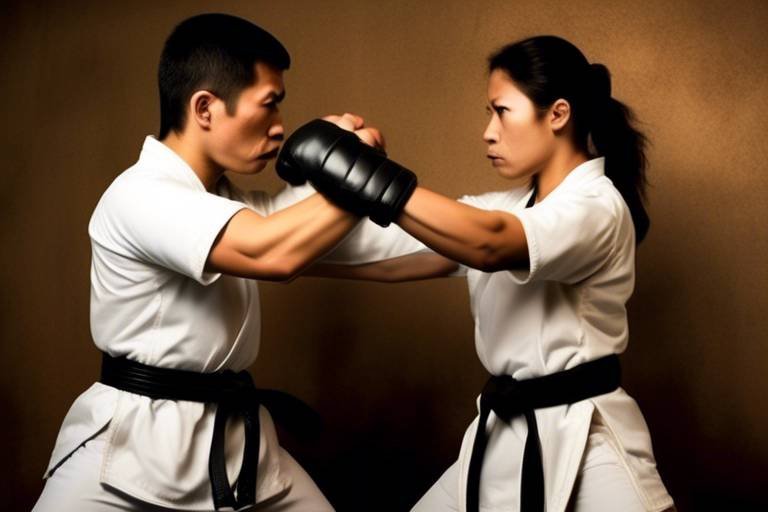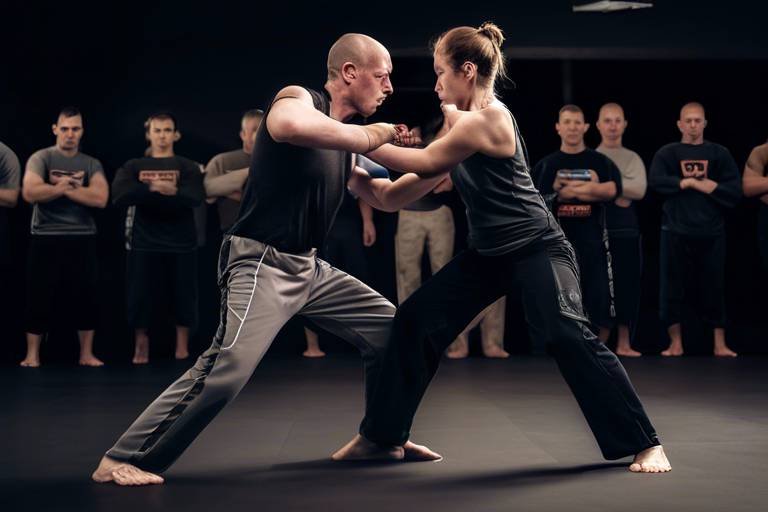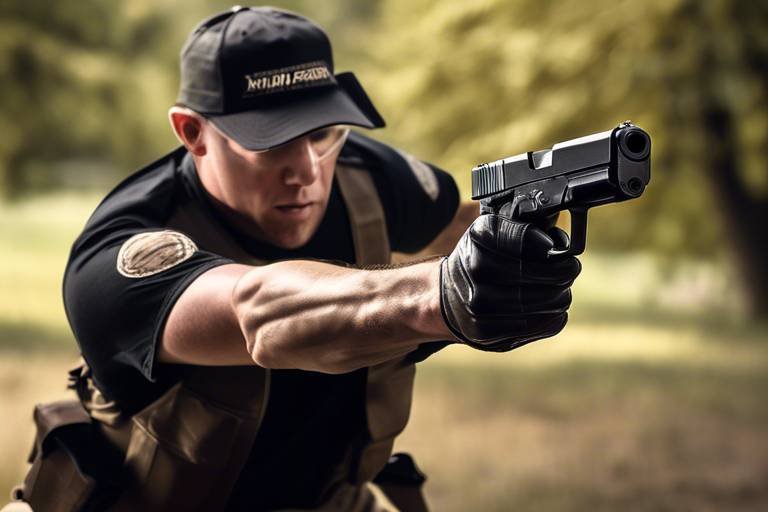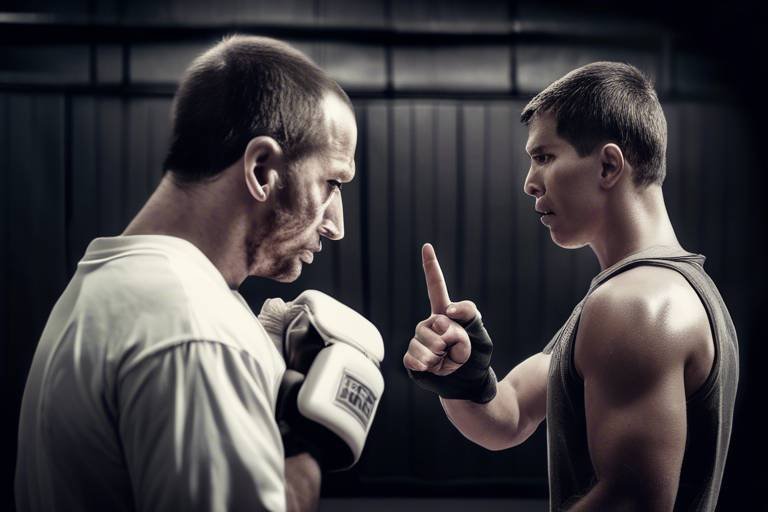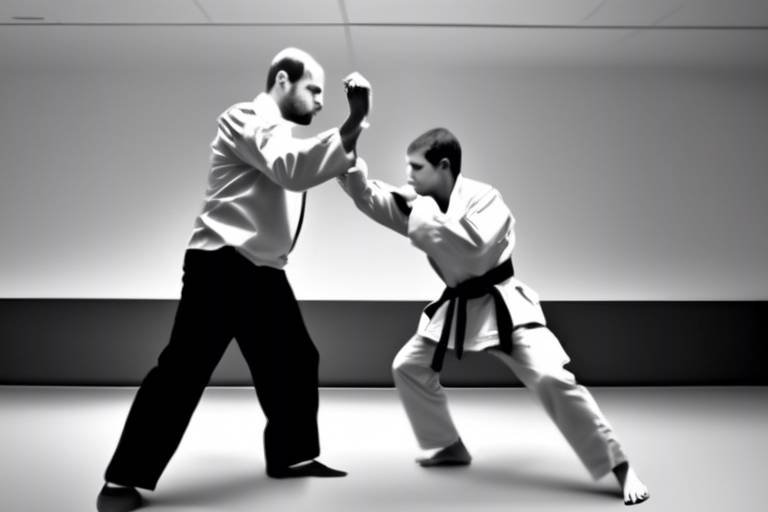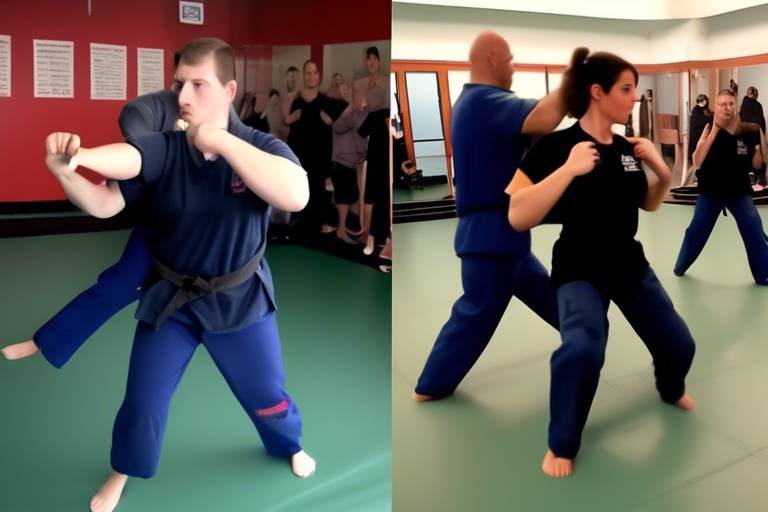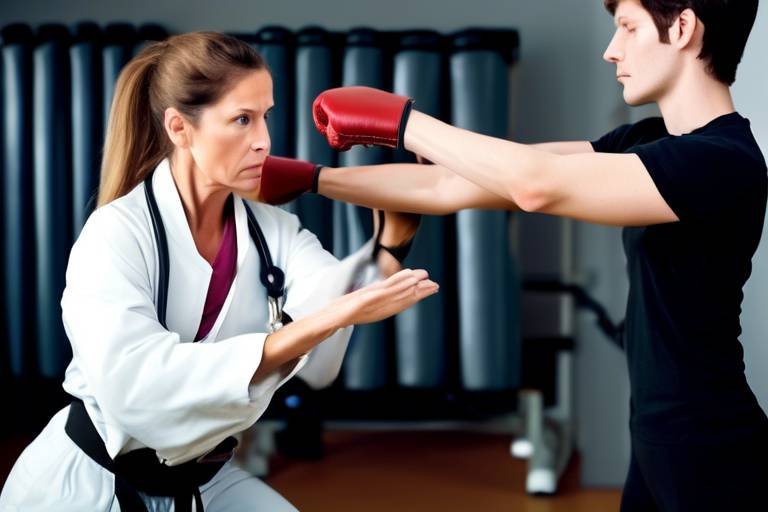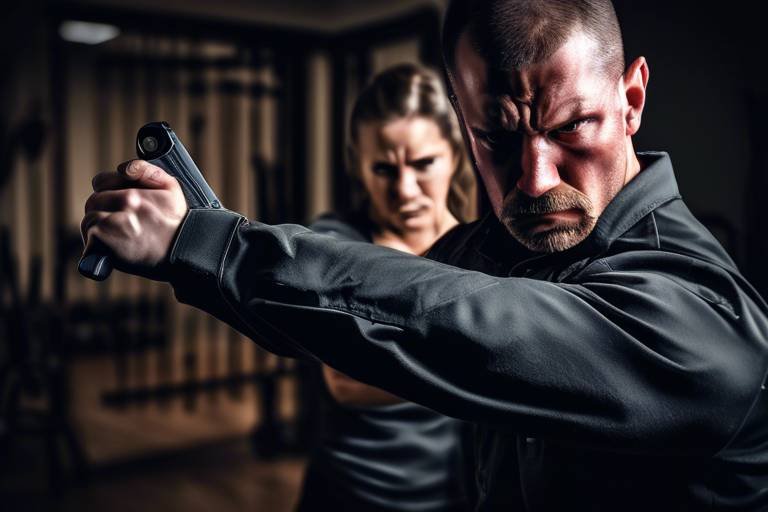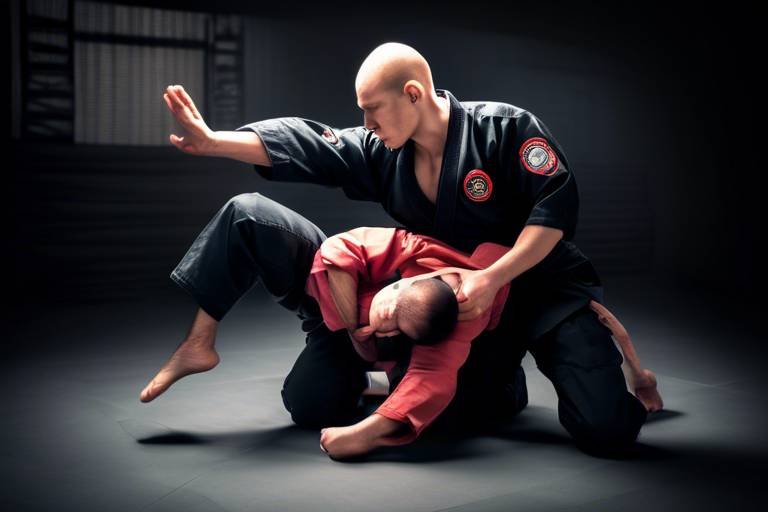How Does Self-Defense Techniques Change with Age?
As we journey through life, our bodies and minds undergo a myriad of changes, which can significantly impact our self-defense capabilities. It's fascinating to think about how the techniques we use to protect ourselves evolve as we age. In our younger years, we might rely on speed, strength, and agility, but as we grow older, these attributes may fade, leading us to adapt our strategies. This article delves into how self-defense techniques transform across different life stages, considering physical, mental, and situational factors that shape our approaches to safety.
One of the most apparent changes that come with age is the decline in physical capabilities. As we age, our muscles weaken, our reflexes slow, and our stamina diminishes. This natural progression can affect the effectiveness of traditional self-defense techniques that often rely on physical prowess. For instance, a young adult might effectively use a takedown maneuver, while an older adult may find it more challenging to execute such moves due to decreased strength and flexibility.
Moreover, older individuals might also experience joint pain, decreased bone density, and other health issues that can limit their ability to engage in physical confrontations. Therefore, it's crucial for aging individuals to reassess their self-defense strategies and focus on techniques that are less physically demanding yet effective. This might include using leverage, redirecting an opponent's energy, or employing techniques that emphasize balance and positioning rather than brute force.
As much as physical changes are significant, mental acuity plays a crucial role in self-defense. Cognitive abilities can shift with age, impacting how we perceive and respond to potential threats. Older adults might not react as quickly as younger individuals, but they often have a wealth of life experience to draw upon, allowing for better situational awareness. This experience can lead to more thoughtful and strategic responses in self-defense scenarios.
For instance, an older adult may recognize a potentially dangerous situation earlier and choose to avoid it altogether, rather than engaging in a confrontation. This proactive approach is often more effective than reactive measures. Additionally, mental exercises and mindfulness practices can help maintain cognitive sharpness, enhancing an individual's ability to assess and respond to threats effectively.
When it comes to self-defense for seniors, adaptation is key. Traditional techniques may need to be modified to accommodate physical limitations without sacrificing effectiveness. For example, instead of relying on high kicks or powerful punches, seniors might benefit from learning techniques that utilize body weight and leverage. These adaptations can include:
- Joint Locks: Techniques that focus on manipulating an attacker's joints can be effective without requiring significant strength.
- Pressure Points: Targeting sensitive areas can incapacitate an attacker with minimal effort.
- Escape Techniques: Learning how to break free from holds or grips can empower seniors to escape dangerous situations.
For older adults, non-violent strategies can be crucial. Engaging in physical confrontations can pose risks, so techniques that prioritize safety without confrontation are essential. De-escalation tactics, such as using calm communication or body language to defuse a situation, can be particularly effective. Additionally, avoidance strategies, such as staying in well-lit areas or avoiding isolated places, can significantly enhance safety. Ultimately, the goal is to avoid conflict whenever possible, which is often the best form of self-defense.
The use of self-defense tools can enhance safety for older individuals. Various tools are accessible and practical, making them valuable additions to a senior's self-defense arsenal. Some popular options include:
- Pepper Spray: Easy to carry and use, it can provide a crucial advantage in a threatening situation.
- Personal Alarms: Loud alarms can attract attention and deter attackers.
- Self-defense Keychains: Compact and discreet, these can be effective in close encounters.
When it comes to children, self-defense training differs significantly from adults. Kids require age-appropriate techniques that not only teach them how to protect themselves but also instill a sense of awareness and confidence. Training should be engaging and fun, incorporating games and scenarios that help children recognize potential dangers while teaching them how to respond appropriately.
Moreover, teaching children the importance of communication, seeking help, and trusting their instincts can be invaluable. It's not just about physical techniques; it's about fostering a mindset that prioritizes safety and awareness.
Gender can influence the approach to self-defense in various ways. Men and women often face different types of threats and may require distinct strategies for self-defense. Understanding these differences is crucial for effective training and practice. For example, women may benefit from techniques that focus on escaping holds or using their surroundings to their advantage.
Social perceptions also play a significant role in how different genders approach self-defense. Societal expectations can shape the techniques chosen for training and the confidence individuals feel in using them. For instance, women might be more likely to face societal pressure to avoid confrontation, which can influence their self-defense training. Addressing these perceptions and empowering individuals to feel confident in their abilities is essential for effective self-defense.
Access to community resources can enhance self-defense skills across all age groups. Many communities offer programs and workshops that cater to various demographics, promoting safety and confidence. These resources can include:
- Local self-defense classes
- Workshops focused on situational awareness
- Community safety events
By participating in these programs, individuals can learn valuable skills, connect with others, and foster a sense of community safety.
1. Can older adults still learn effective self-defense techniques?
Absolutely! While techniques may need to be adapted, older adults can still learn effective self-defense strategies that suit their physical capabilities.
2. What are some good self-defense tools for seniors?
Tools like pepper spray, personal alarms, and self-defense keychains are practical options for seniors to enhance their safety.
3. How can children be taught self-defense?
Children should be taught age-appropriate techniques that emphasize awareness, confidence, and safe responses to potential threats.
4. Are there community resources available for self-defense training?
Yes, many communities offer workshops and classes that cater to different age groups, promoting safety and self-defense skills.

Physical Changes and Self-Defense
As we journey through life, our bodies undergo a myriad of changes that can significantly impact our physical capabilities. These changes can be particularly pronounced as we age, affecting our strength, flexibility, and overall agility. Understanding how these physical transformations influence self-defense techniques is crucial for individuals of all ages. Think about it: a young athlete might rely on speed and strength, while an older adult may need to adapt their strategies to account for reduced physical prowess.
When we consider the aging process, several key physical changes come into play:
- Decreased Muscle Mass: Sarcopenia, or the loss of muscle mass, is a common occurrence as we age. This decline can lead to reduced strength, making it more challenging to execute certain self-defense maneuvers that require physical force.
- Reduced Flexibility: As we age, our joints may become stiffer, which can limit our range of motion. This reduced flexibility can hinder the ability to perform techniques that require quick, agile movements.
- Slower Reaction Times: Cognitive processing speeds can slow down, leading to delayed reactions in high-pressure situations. This can be a critical factor in self-defense scenarios where split-second decisions are essential.
These physical changes necessitate a reevaluation of self-defense strategies. For instance, older individuals may find that techniques relying heavily on brute strength are less effective. Instead, they might benefit from strategies that emphasize leverage, timing, and awareness rather than sheer force. Adopting a more strategic approach to self-defense can empower older adults to protect themselves effectively.
Moreover, it’s essential to recognize that self-defense isn't just about physical confrontation. It can also involve using one's surroundings to one’s advantage. For example, positioning oneself near objects that can be used as barriers or shields can help mitigate physical limitations. Additionally, understanding how to read a situation and recognizing potential threats can be invaluable skills that don’t rely on physical capabilities alone.
In conclusion, while aging brings about inevitable physical changes that can affect self-defense techniques, it also opens the door to new strategies that prioritize safety and awareness. By embracing these adaptations, individuals can maintain their confidence and effectiveness in self-defense situations, regardless of age.

Mental Awareness and Self-Defense
Mental awareness plays a crucial role in self-defense, regardless of age. As we journey through life, our cognitive abilities can evolve, impacting our situational awareness and, ultimately, our self-defense strategies. Imagine walking down a street; a young person might be more focused on their phone, while an older adult might be more attuned to their surroundings. This difference illustrates how age can influence mental acuity and awareness.
For younger individuals, self-defense often emphasizes physical prowess, quick reflexes, and aggressive techniques. However, as people age, they may find that their physical capabilities decline, but their mental acuity can still be a powerful tool. Older adults often develop a heightened sense of awareness through life experiences, allowing them to assess situations more critically. This shift means that the focus of self-defense can transition from physical confrontation to strategic avoidance and de-escalation.
It's essential to recognize that mental awareness includes not only the ability to perceive potential threats but also the capacity to respond appropriately. This involves understanding one's surroundings, recognizing potential dangers, and making quick decisions. In fact, studies have shown that individuals with high situational awareness are often better equipped to avoid confrontations altogether. This brings us to the importance of training that enhances mental awareness, especially for older adults who may not feel as physically capable.
Training programs tailored for older adults can focus on developing mental strategies that complement physical techniques. These programs might include:
- Situational awareness exercises: Practicing how to recognize and assess potential threats in various environments.
- Role-playing scenarios: Engaging in simulated situations to improve decision-making under pressure.
- Mindfulness techniques: Learning to stay present and focused, which can help in identifying dangers before they escalate.
Moreover, understanding the psychology behind self-defense is vital. Older adults might feel vulnerable, leading to anxiety in potentially dangerous situations. By enhancing mental awareness, they can build confidence, allowing them to navigate their environments more securely. This confidence can be as powerful as any physical technique, as it may deter potential threats simply by projecting a sense of awareness and preparedness.
In conclusion, mental awareness is a dynamic aspect of self-defense that evolves with age. By prioritizing cognitive training and situational awareness, individuals can adapt their self-defense strategies to align with their current capabilities. This shift not only empowers them but also enhances their overall safety and confidence in everyday life.
- How can older adults improve their mental awareness for self-defense? Engaging in situational awareness exercises, mindfulness practices, and role-playing scenarios can significantly enhance mental acuity.
- Are there specific training programs for seniors? Yes, many community centers and organizations offer self-defense classes tailored for older adults, focusing on mental strategies and physical adaptations.
- Can mental awareness compensate for physical limitations in self-defense? Absolutely! A heightened sense of awareness and strategic thinking can often help avoid confrontations altogether, making it a valuable asset.

Adapting Techniques for Seniors
As we gracefully age, our bodies undergo a series of changes that can affect our physical abilities, making it essential to adapt self-defense techniques accordingly. The reality is that what worked in our younger years may not be as effective or feasible as we grow older. This doesn’t mean that seniors should shy away from self-defense; rather, it calls for a thoughtful approach to modifying techniques to suit their evolving capabilities.
One of the most significant factors to consider is balance. As we age, our balance can diminish, making it harder to execute certain physical maneuvers. Traditional self-defense techniques often rely on quick movements and agility, which may not be practical for everyone. Therefore, seniors should focus on techniques that emphasize stability and leverage rather than speed. For instance, instead of attempting a high kick or a rapid jab, a senior might find it more effective to use their body weight to push an assailant away or to employ simple blocking techniques that require less mobility.
Additionally, the element of strength can wane with age. This doesn’t mean that seniors are powerless; instead, they can utilize their environment and everyday objects to enhance their defenses. For example, using a cane or even a handbag can serve as effective tools for self-defense. By incorporating these items into their techniques, seniors can maintain a level of effectiveness without relying solely on their physical strength.
Moreover, awareness becomes even more crucial as we age. Seniors should focus on developing their situational awareness to help them avoid potentially dangerous situations altogether. This can be achieved through practice and training that emphasizes observation and intuition. For example, attending workshops that teach self-defense strategies tailored for seniors can boost confidence and provide valuable skills without the physical strain of traditional training.
In adapting self-defense techniques for seniors, it's also important to consider the psychological aspect. Many seniors may feel intimidated by the idea of confrontation. Therefore, training should include a strong emphasis on verbal de-escalation techniques. These strategies can help seniors diffuse situations before they escalate into physical confrontations, prioritizing safety and peace over aggression.
In summary, adapting self-defense techniques for seniors involves a combination of modifying physical movements, utilizing environmental resources, enhancing awareness, and incorporating verbal strategies. By focusing on these areas, seniors can feel empowered and prepared to protect themselves without compromising their safety or well-being.

Use of Non-violent Strategies
When it comes to self-defense, especially for older adults, non-violent strategies can be not only effective but also essential. The idea is to prioritize safety without escalating a situation into physical confrontation. Imagine walking through a park and sensing that someone is following you. Instead of resorting to physical tactics, employing non-violent strategies can often diffuse the potential threat while keeping you safe.
One of the most important non-violent strategies is de-escalation. This involves using calm communication to defuse a tense situation. For instance, if confronted, maintaining a steady voice and expressing understanding can sometimes redirect the aggressor's focus. It’s akin to being a firefighter who uses water to put out flames instead of adding fuel to the fire. Here are some practical techniques:
- Body Language: Adopting an open and non-threatening posture can signal to others that you mean no harm.
- Verbal De-escalation: Using phrases like “I understand your frustration” can help to calm down an aggressive individual.
- Creating Distance: If possible, maintaining physical distance can prevent escalation while allowing you time to assess the situation.
Another vital aspect of non-violent strategies is the use of avoidance techniques. This means recognizing potentially dangerous situations and steering clear of them whenever possible. Think of it like a chess game; sometimes, the best move is to retreat and reposition rather than engage directly. For older adults, this could mean:
- Avoiding poorly lit areas at night.
- Staying away from isolated places where help may not be readily available.
- Choosing to walk in groups rather than alone, which can deter potential aggressors.
Incorporating these non-violent strategies into daily life not only enhances personal safety but also fosters a sense of confidence and control. It's about being proactive rather than reactive. The more awareness you cultivate about your surroundings and the potential risks, the better prepared you'll be to handle unexpected encounters without resorting to violence.
Ultimately, the goal of self-defense, especially for older adults, is to navigate through life with peace of mind. By focusing on non-violent methods, individuals can empower themselves to handle potentially dangerous situations effectively and safely. Remember, it’s not just about defending oneself; it’s about creating an environment where one can feel secure and confident in their ability to manage threats without confrontation.
Q: What are non-violent strategies in self-defense?
A: Non-violent strategies include techniques like de-escalation, avoidance, and effective communication to diffuse potentially dangerous situations without physical confrontation.
Q: Why are non-violent strategies important for older adults?
A: Non-violent strategies are crucial for older adults as they may have physical limitations. These strategies allow them to prioritize safety while minimizing the risk of injury.
Q: Can non-violent strategies be effective in all situations?
A: While not every situation can be resolved without confrontation, many can. The effectiveness of non-violent strategies often relies on the individual's ability to assess the situation and respond appropriately.

Self-Defense Tools for Older Adults
As we age, the importance of self-defense tools becomes increasingly evident. For older adults, the right tools can provide a sense of security and confidence, allowing them to navigate their environments with peace of mind. It's essential to recognize that self-defense isn't solely about physical strength; it's also about smart choices and utilizing resources effectively. In this section, we’ll explore various self-defense tools that are not only accessible but also practical for older individuals.
One of the most popular self-defense tools for older adults is a personal alarm. These small devices emit a loud sound when activated, drawing attention to the user and potentially scaring off an assailant. They are easy to carry and can be attached to keychains or bags, making them a convenient option. Another effective tool is a pepper spray. While it requires some practice to use effectively, it can incapacitate an attacker long enough for the user to escape. It's important to check local laws regarding the carrying and use of pepper spray, as regulations can vary.
Additionally, older adults might consider carrying a tactical flashlight. Not only can it illuminate dark areas, but it can also be used to temporarily blind an attacker, giving the user precious moments to escape. Furthermore, these flashlights are often designed to be durable and can withstand rough handling, making them a reliable choice.
Incorporating self-defense tools into daily life can be empowering. For example, many older adults benefit from taking self-defense classes that specifically teach how to use these tools effectively. Such classes often emphasize situational awareness, which is crucial for recognizing potential threats before they escalate.
It's also worth mentioning that community resources often provide workshops focused on self-defense for seniors. These programs not only teach practical skills but also foster a sense of community and support among participants. Engaging with others in similar situations can enhance learning and build confidence.
In conclusion, self-defense tools for older adults are not just about physical confrontation; they are about enhancing personal safety and confidence. By choosing the right tools and seeking out educational resources, older individuals can significantly improve their ability to protect themselves in various situations.
- What are the best self-defense tools for older adults?
Some of the best tools include personal alarms, pepper spray, and tactical flashlights. Each of these tools offers unique advantages in terms of safety and ease of use. - Are self-defense classes beneficial for seniors?
Yes, self-defense classes can be incredibly beneficial. They not only teach practical skills but also boost confidence and situational awareness. - How can I find community resources for self-defense training?
Many community centers, local law enforcement agencies, and senior organizations offer self-defense workshops. Checking their websites or contacting them directly can provide more information.

Children and Self-Defense Training
When it comes to , the approach is vastly different from that of adults. Kids are not only smaller but also have a different understanding of their surroundings and how to react to various situations. So, how do we equip them with the skills they need to stay safe? The key lies in teaching them age-appropriate techniques that are both effective and easy to grasp.
One of the most important aspects of self-defense for children is fostering awareness. Kids should learn to recognize potential threats in their environment. This includes understanding the difference between safe and unsafe situations, as well as identifying people or circumstances that may pose a risk. For instance, teaching them to trust their instincts can be a game-changer. If something feels off, they should know it's okay to remove themselves from that situation.
Moreover, self-defense training for children should focus on building confidence. When children feel empowered, they are more likely to stand up for themselves and seek help when needed. Simple drills that include verbal assertiveness can go a long way. For example, practicing statements like, “No, I don’t want to play,” helps kids learn to communicate their boundaries effectively.
It's also essential to incorporate physical techniques that are suitable for their size and strength. Unlike adults, children may not have the same physical capabilities, so self-defense moves should be tailored to their abilities. Techniques such as:
- Escaping from a wrist grab
- Using their body weight to push away an aggressor
- Creating distance to escape
These moves are not only practical but also help children understand the importance of using their environment to their advantage. For instance, if a child is grabbed, they can learn to pivot and use their body weight to break free, rather than trying to overpower an adult.
Another crucial element of self-defense training for children is teaching them about non-violent conflict resolution. This includes understanding how to de-escalate a situation verbally before it turns physical. Role-playing scenarios can be a fun and effective way for kids to practice these skills. They can learn phrases to use when feeling threatened, such as asking the person to stop or walking away to find help.
In addition to physical and verbal techniques, it's important to discuss the use of technology in self-defense. With the rise of smartphones, children can learn how to use their devices to call for help or alert trusted adults if they find themselves in a troubling situation. Teaching children to always have their phones charged and within reach can be a practical safety measure.
Ultimately, self-defense training for children is about more than just physical techniques; it’s about instilling a sense of security and empowerment. When children know how to protect themselves, they gain confidence that extends beyond self-defense situations. They learn to trust their instincts, communicate effectively, and navigate the world with a sense of safety and awareness.
Q: At what age should children start self-defense training?
A: Children can begin basic self-defense training as early as 5 or 6 years old. The focus should be on awareness and simple techniques appropriate for their age.
Q: What should parents look for in a self-defense program for children?
A: Parents should seek programs that emphasize safety, confidence-building, and age-appropriate techniques. It's also beneficial if the instructors have experience working with children.
Q: How can parents reinforce self-defense lessons at home?
A: Parents can role-play various scenarios with their children, discuss safety strategies, and encourage open conversations about their feelings and experiences.

Gender Differences in Self-Defense
When it comes to self-defense, gender differences play a significant role in shaping the techniques and strategies individuals choose to adopt. It's not just about physical strength; it's also about how society perceives gender roles and the unique challenges each gender faces. For instance, men are often socialized to be more aggressive and assertive, which can influence their approach to self-defense. In contrast, women may be more inclined to emphasize avoidance and de-escalation tactics, reflecting societal expectations of femininity and safety.
Moreover, physical differences can affect the effectiveness of certain self-defense techniques. Generally, men tend to have greater upper body strength, which can make techniques that rely on brute force more effective for them. Women, on the other hand, may need to focus on techniques that utilize leverage and agility rather than strength. This is where techniques such as joint locks and pressure points become essential, as they allow individuals to defend themselves effectively without relying on physical power alone.
Another important aspect to consider is the psychological impact of self-defense training. Men often report feeling empowered by learning self-defense techniques, which can boost their confidence in various situations. Women, however, may face different emotional barriers, such as fear of confrontation or societal judgment. This can make it more challenging for women to engage fully in self-defense training. Therefore, creating a supportive environment that encourages all genders to participate without fear of judgment is crucial.
To further understand gender differences in self-defense, let’s break down some common perceptions:
| Aspect | Men | Women |
|---|---|---|
| Physical Strength | Generally higher upper body strength | May rely more on technique than strength |
| Socialization | Encouraged to be assertive and aggressive | Encouraged to prioritize safety and avoidance |
| Emotional Barriers | May feel empowered by training | May face fear of confrontation or judgment |
In the context of self-defense training, it’s vital to recognize these differences and tailor approaches accordingly. Workshops and classes should be designed to address the specific needs and concerns of both genders. For example, women’s self-defense classes often incorporate situational awareness, verbal de-escalation, and escape techniques, which are crucial for their unique circumstances.
Furthermore, understanding social perceptions can help bridge the gap in self-defense training. Society often expects men to be protectors and women to be passive, which can lead to misunderstandings in training environments. By fostering a culture of inclusivity and respect, we can empower individuals of all genders to develop their self-defense skills confidently.
In conclusion, gender differences in self-defense are complex and multifaceted. By acknowledging these differences and adapting training methods, we can create safer environments for everyone. Whether you identify as male, female, or non-binary, self-defense is a vital skill that can enhance personal safety and instill confidence.
- What self-defense techniques are best for women?
Women often benefit from techniques that focus on leverage, joint locks, and awareness. Classes that emphasize de-escalation and escape strategies can also be very effective. - Are men and women trained differently in self-defense?
Yes, training can differ based on physical and psychological factors. Men might focus more on strength-based techniques, while women may learn more about avoidance and self-awareness. - How can I find a self-defense class that suits my needs?
Look for local classes that cater to your gender and experience level. Many community centers offer specialized programs designed for different age groups and genders.

Social Perceptions and Self-Defense
Social perceptions play a significant role in shaping how individuals approach self-defense. These perceptions are often influenced by cultural norms, media portrayals, and personal experiences. For instance, many people associate self-defense with physical confrontation, leading to a narrow view of what self-defense truly entails. This misconception can deter individuals from exploring non-violent strategies that can be just as effective, if not more so, in certain situations.
Moreover, gender expectations can heavily influence how self-defense is perceived and practiced. Traditionally, society has imposed specific roles on men and women, often leading to the belief that men should be the primary protectors while women should adopt a more passive role. This creates a disparity in training opportunities and confidence levels. As a result, many women may feel less empowered to engage in self-defense training, fearing that they won't meet societal expectations.
It’s essential to recognize that self-defense is not solely about physical prowess; it also encompasses mental preparation and situational awareness. The idea that only the physically strong can defend themselves is not only outdated but also misleading. Individuals of all shapes, sizes, and genders can learn effective techniques that suit their unique strengths. By shifting the narrative around self-defense, we can encourage more people to take charge of their safety and well-being.
To illustrate the impact of social perceptions, consider the following table that summarizes how different demographics view self-defense:
| Demographic | Common Perception | Impact on Training |
|---|---|---|
| Men | Physical strength is paramount | Focus on aggressive techniques |
| Women | Self-defense is primarily for men | Less participation in training |
| Seniors | Self-defense is too physical | Overlook non-violent techniques |
| Children | Self-defense is only for emergencies | Lack of awareness training |
Breaking down these stereotypes is crucial for fostering a more inclusive approach to self-defense. When individuals feel supported and encouraged, regardless of their gender or age, they are more likely to engage in self-defense training. This not only boosts their confidence but also enhances their ability to respond effectively in potentially dangerous situations.
Furthermore, community resources can play a pivotal role in reshaping social perceptions. Workshops and classes that emphasize self-defense as a skill accessible to everyone can help demystify the practice. By promoting a culture where self-defense is seen as a vital life skill rather than a last resort, we can empower individuals to take control of their safety.
In conclusion, understanding and addressing social perceptions surrounding self-defense is essential for creating a more equitable environment. By fostering inclusivity and breaking down stereotypes, we can ensure that everyone has the opportunity to learn self-defense techniques that suit their needs, ultimately leading to a safer society.
- What is self-defense? Self-defense refers to the actions taken to protect oneself from physical harm.
- Can women learn self-defense? Absolutely! Self-defense techniques are designed for individuals of all genders and physical abilities.
- Are non-violent strategies effective? Yes, non-violent strategies such as de-escalation and avoidance can be very effective in many situations.
- What age is appropriate for self-defense training? Self-defense training can be beneficial for individuals of all ages, from children to seniors.

Community Resources for All Ages
When it comes to self-defense, having access to community resources can be a game changer for individuals of all ages. Whether you’re a sprightly teenager, a busy adult, or a seasoned senior, there are numerous programs and workshops designed to enhance your self-defense skills and boost your confidence. These resources not only provide training but also foster a sense of community and support. Imagine walking into a local self-defense class, surrounded by people who share your desire to learn and protect themselves. It’s not just about learning techniques; it’s about building connections and empowering each other.
Many communities offer a variety of self-defense classes tailored to different age groups and skill levels. For instance, local community centers often host workshops that cover everything from basic awareness to advanced techniques. These classes typically focus on practical skills that can be applied in real-life situations, making them incredibly valuable. Furthermore, some organizations even provide free or subsidized classes to ensure that everyone can access this essential training, regardless of their financial situation.
In addition to physical training, community resources often include educational seminars that discuss the importance of mental awareness and personal safety. These sessions can cover a range of topics, such as:
- Understanding the psychology of an attacker
- Recognizing potential threats in your environment
- Developing a safety mindset
Many community resources also encourage family participation, making self-defense training a fun and engaging activity for all ages. Parents can enroll their children in classes that teach age-appropriate techniques, which not only prepares them for potential dangers but also instills a sense of confidence and independence. The beauty of these programs is that they often emphasize the importance of non-violent strategies, such as de-escalation and avoidance, which are crucial for younger individuals who may not yet have the physical strength to defend themselves effectively.
Moreover, some community organizations partner with local law enforcement to provide specialized training sessions. These collaborations can offer unique insights into real-world scenarios, helping participants understand how to respond effectively in emergencies. It’s a fantastic opportunity to learn from those who deal with safety and security daily. Imagine being able to ask a police officer questions about self-defense and safety in your neighborhood!
Overall, community resources play a vital role in equipping individuals with the knowledge and skills necessary for self-defense. They create an inclusive environment where everyone, regardless of age or ability, can learn and grow. So, why not check out what’s available in your area? You might be surprised at the variety of options out there, from martial arts studios to local nonprofits focused on personal safety.
In conclusion, investing time in community resources for self-defense is not just about learning how to fight; it’s about fostering a culture of safety and awareness that benefits everyone. By participating in these programs, you contribute to a stronger, more resilient community that prioritizes the well-being of its members.
Frequently Asked Questions
- How do physical changes affect self-defense techniques as we age?
As we age, our physical strength, agility, and reflexes may decline. This means that traditional self-defense techniques that rely on speed and power might not be as effective for older individuals. Instead, adapting techniques to focus on leverage, technique, and using an opponent's force against them becomes crucial. It's all about working smarter, not harder!
- What mental changes should I be aware of regarding self-defense?
Cognitive abilities can shift with age, affecting our situational awareness and reaction times. Older adults might find themselves needing to rely more on their instincts and experience rather than quick reflexes. It's important to stay mentally sharp through training and practice, as a keen mind can often outsmart a stronger opponent.
- What adaptations can seniors make to traditional self-defense techniques?
Seniors can modify techniques by focusing on defensive maneuvers that require less physical exertion. For example, using body positioning and creating distance can be effective strategies. Additionally, practicing techniques that emphasize escape and evasion rather than confrontation can help seniors feel more empowered and safe.
- Are there non-violent strategies that older adults can use?
Absolutely! Non-violent strategies, such as de-escalation techniques, are vital for older adults. These include using calm communication, maintaining a non-threatening posture, and avoiding confrontation whenever possible. Learning how to diffuse a situation can often prevent violence before it starts.
- What self-defense tools are recommended for older adults?
Older adults can benefit from tools like personal alarms, pepper spray, or even tactical pens, which are lightweight and easy to carry. The key is to choose something that feels comfortable and manageable, ensuring that they can use it effectively in a stressful situation.
- How should children's self-defense training differ from adults'?
Children's self-defense training should focus on age-appropriate techniques that emphasize awareness, confidence, and basic defensive moves. It's essential to teach kids how to recognize dangerous situations and respond appropriately, rather than relying solely on physical confrontation.
- Are there gender differences in self-defense approaches?
Yes, gender can influence self-defense techniques and training approaches. Generally, women may focus more on awareness and avoidance strategies, while men might emphasize physical techniques. Understanding these differences can help tailor training to be more effective for each individual.
- How do social perceptions affect self-defense training?
Social perceptions can shape how individuals approach self-defense. For example, societal expectations may lead women to feel they need to rely on verbal de-escalation, while men might feel pressured to engage physically. Recognizing these influences can help individuals choose training that aligns with their personal comfort and safety needs.
- What community resources are available for self-defense training?
Many communities offer self-defense workshops, classes, and resources tailored for various age groups. These programs often focus on practical skills, situational awareness, and confidence-building strategies. Checking with local community centers or martial arts studios can uncover valuable opportunities for training.


